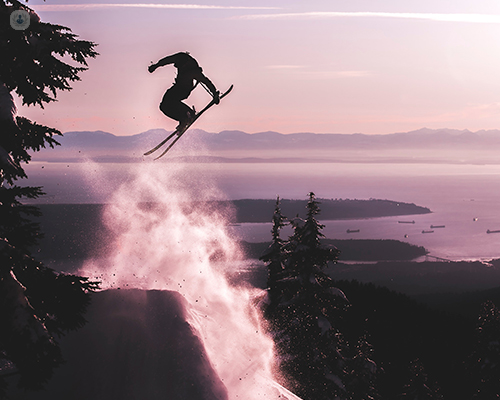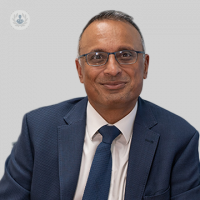Skiing and knee injuries
Autore:Skiing and snowboarding are inherently risky sports. Injuries are fairly common, and of these, around a third involve the knee. Skilled orthopaedic surgeon Mr Paul Trikha explains.

Skiing and snowboarding injuries: quick facts
- Snowboarders suffer half the rate of injuries of skiers.
- Skiing off-piste raises the risk of injury eightfold.
- Knee injuries from skiing are extremely common and account for about 1/3 of all skiing injuries.
- In the knee, the anterior cruciate ligament (ACL) and the medial collateral ligament (MCL) are the most commonly injured; meniscal cartilage injuries and fractures are next most frequent.
Anterior cruciate ligament (ACL) ski injuries
This frequently happens when a skier lands badly and twists the knee. Often the binding will not release. There may be a ‘popping’ sound and an inability to bear weight on the knee due to pain and/or instability, with the feeling that your knee will give way.
The ACL helps to keep the knee joint stable by preventing the top of the tibia sliding forward on the bottom of the femur. About half of all ACL injuries occur in combination with other knee injuries, such as meniscus tears or damage to other structures of the knee, such as articular cartilage and other ligaments. An MRI scan is often required to help establish the diagnosis.
Medial collateral ligament (MCL) ski injuries
MCL injury is common and often associated with the snow-plough position (i.e. having your skis pointed inwards at the front, with tails wider apart), and so is common in beginner skiers. It can also be caused by a fall, skis crossing, a missed landing on a snowboard.
The MCL has the capacity to heal without surgery when managed appropriately. Medial collateral injuries can be treated with physiotherapy, or with bracing for periods of up to three months in the more severe cases. Surgical reconstruction is rarely required in isolated MCL injuries.
Mensicus or cartilage ski injuries:
Large meniscal cartilage tears can cause the knee to lock due to a piece of the meniscus having been flipped into the joint, preventing full extension or straightening of the knee. Most large meniscal tears can be repaired with keyhole arthroscopic surgery.
What should I do if I injure my knee?
I recommend applying the P.O.L.I.C.E principal immediately. P.O.L.I.C.E is an acronym for Protection and Optimal Loading (knee support or brace with crutches), Ice, and Compression & Elevation.
You should seek an urgent opinion from a knee specialist on how to best manage your knee.
Do I need surgery for my ACL tear?
Surgery is not for everyone. The treatment of a torn anterior cruciate ligament can be conservative with active participation in a structured rehabilitation program under the supervision of an experienced physiotherapist. The outcomes for surgical ACL reconstruction are very reliable, allowing over 90% to return to sport.
Should I have my ACL repaired (ACL Internal Brace or ACL Ligamys®) or reconstructed?
The current gold standard of care for an ACL rupture is ACL reconstruction using a graft taken from the patient (hamstring, patella or quadriceps tendon). ACL reconstruction is usually effective at restoring joint stabilisation and should be performed soon after the injury, thereby preventing subsequent meniscal or cartilage injury.
ACL repair is a resurging technique and maybe indicated if there is sufficient remaining good quality ACL tissue. There are a number of new innovative implant techniques such as the InternalBrace™ and Ligamys® ACL systems, which allow preservation and even healing of this ACL tissue.
ACL repair avoids taking any graft from the patient. Other potential benefits associated with ACL repair over reconstruction include preservation of biomechanics, proprioception, and walking patterns.
When can I return to skiing after ACL surgery?
When you’re near your end of your rehabilitation, your physio will complete ‘return to sport’ testing as part of your end stage rehabilitation. This is a structured battery of tests that reflect the physical demands of the sport or sports that you are aiming to return to. Typically, this occurs from 6-9 months. However the risk of re-injury is still high at even two years post-injury.
If you are concerned about ski-related knee injuries, visit Mr Trikha’s Top Doctors profile and book a consultation.



